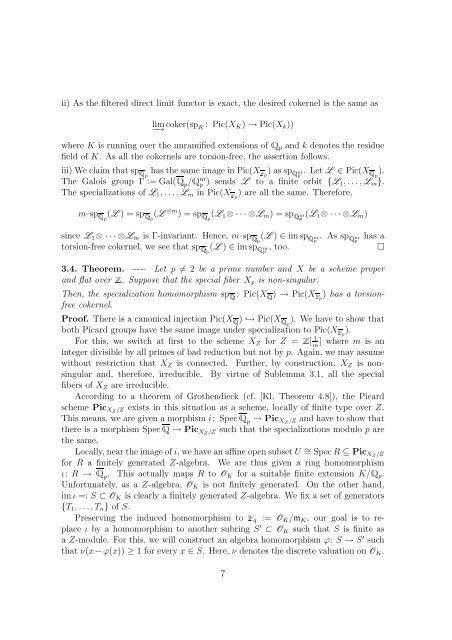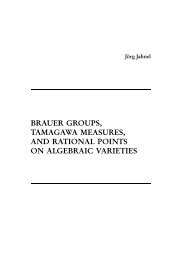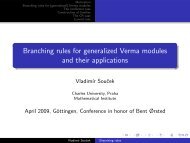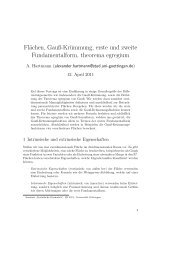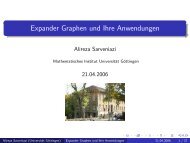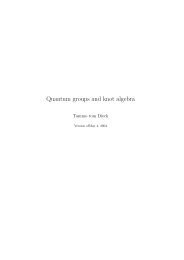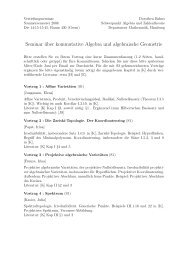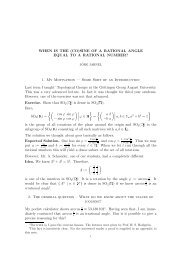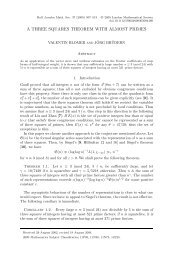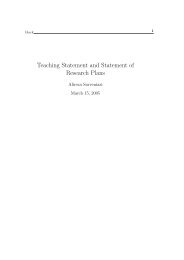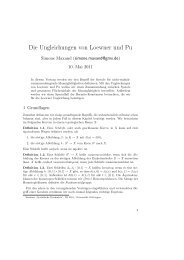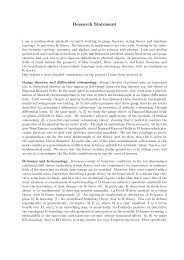The Picard group of a K3 surface and its reduction modulo p
The Picard group of a K3 surface and its reduction modulo p
The Picard group of a K3 surface and its reduction modulo p
You also want an ePaper? Increase the reach of your titles
YUMPU automatically turns print PDFs into web optimized ePapers that Google loves.
ii) As the filtered direct limit functor is exact, the desired cokernel is the same as<br />
lim<br />
−→ coker(sp K : Pic(X K ) → Pic(X k ))<br />
where K is running over the unramified extensions <strong>of</strong>Ép <strong>and</strong> k denotes the residue<br />
field <strong>of</strong> K. As all the cokernels are torsion-free, the assertion follows.<br />
iii) We claim that has the same image in ) as spÉnr. Let L ∈ ).<br />
spÉp<br />
Pic(Xp p<br />
Pic(XÉp<br />
<strong>The</strong> Galois <strong>group</strong> Γ := Gal(Ép/Énr<br />
p ) sends L to a finite orbit {L 1, . . .,L m }.<br />
<strong>The</strong> specializations <strong>of</strong> L 1 , . . ., L m in ) are all the same. <strong>The</strong>refore,<br />
Pic(Xp<br />
m·spÉp (L ) = spÉp (L ⊗m ) = spÉp (L 1⊗ · · · ⊗L m ) = spÉnr<br />
p (L 1⊗ · · · ⊗L m )<br />
since L 1 ⊗ · · · ⊗L m is Γ-invariant. Hence, m·spÉp<br />
torsion-free cokernel, we see that spÉp<br />
(L ) ∈ im spÉnr<br />
p , too.<br />
(L ) ∈ im spÉnr. As spÉnr<br />
p p<br />
has a<br />
□<br />
3.4. <strong>The</strong>orem. –––– Let p ≠ 2 be a prime number <strong>and</strong> X be a scheme proper<br />
<strong>and</strong> flat over. Suppose that the special fiber X p is non-singular.<br />
<strong>The</strong>n, the specialization homomorphism spÉ: Pic(XÉ) → ) has a torsionfree<br />
Pic(Xp<br />
cokernel.<br />
Pro<strong>of</strong>. <strong>The</strong>re is a canonical injection Pic(XÉ) ֒→ ). We have to show that<br />
Pic(XÉp<br />
both <strong>Picard</strong> <strong>group</strong>s have the same image under specialization to ). Pic(Xp<br />
For this, we switch at first to the scheme X Z for Z =[ 1 ] where m is an<br />
m<br />
integer divisible by all primes <strong>of</strong> bad <strong>reduction</strong> but not by p. Again, we may assume<br />
without restriction that X Z is connected. Further, by construction, X Z is nonsingular<br />
<strong>and</strong>, therefore, irreducible. By virtue <strong>of</strong> Sublemma 3.1, all the special<br />
fibers <strong>of</strong> X Z are irreducible.<br />
According to a theorem <strong>of</strong> Grothendieck (cf. [Kl, <strong>The</strong>orem 4.8]), the <strong>Picard</strong><br />
scheme Pic XZ /Z exists in this situation as a scheme, locally <strong>of</strong> finite type over Z.<br />
This means, we are given a morphism i: SpecÉp → Pic XZ /Z <strong>and</strong> have to show that<br />
there is a morphism SpecÉ→Pic XZ /Z such that the specializations <strong>modulo</strong> p are<br />
the same.<br />
Locally, near the image <strong>of</strong> i, we have an affine open subset U ∼ = Spec R ⊆ Pic XZ /Z<br />
for R a finitely generated Z-algebra. We are thus given a ring homomorphism<br />
ι: R →Ép. This actually maps R to O K for a suitable finite extension K/Ép.<br />
Unfortunately, as a Z-algebra, O K is not finitely generated. On the other h<strong>and</strong>,<br />
im ι =: S ⊂ O K is clearly a finitely generated Z-algebra. We fix a set <strong>of</strong> generators<br />
{T 1 , . . ., T n } <strong>of</strong> S.<br />
Preserving the induced homomorphism toq := O K /m K , our goal is to replace<br />
ι by a homomorphism to another subring S ′ ⊂ O K such that S is finite as<br />
a Z-module. For this, we will construct an algebra homomorphism ϕ: S → S ′ such<br />
that ν(x −ϕ(x)) ≥ 1 for every x ∈ S. Here, ν denotes the discrete valuation on O K .<br />
7


